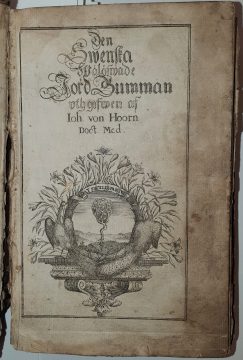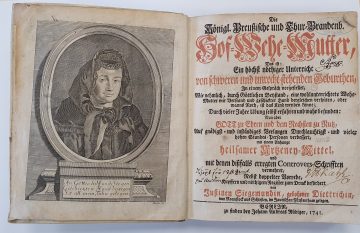MEDICAL HISTORY. As science gained a foothold in the 17th century, physicians turned their attention to childbirth, leading the oral traditions and knowledge of midwives finally being preserved in books. The Biomedical Library is now restoring several historic books that they received as a donation from the Institute of Health and Care Sciences. Jenna Harju, conservator at the Biomedical Library, provides some insight into this preservation work.

The books show how maternity care has developed from being based primarily on oral tradition to becoming a recognized scientific field.
 Among the donations is Johan von Hoorn’s work from 1697, with the long title Den swenska wäl-öfwade jord-gumman hwilken grundeligen underwijser huru med en hafwande handlas, en wåndande hielpas, en barna-qwinna handteras, och det nyfödnad barn skiötas skal [Detailed instructions from an experienced Swedish midwife on caring for pregnant women, relieving pain, assisting with a birth, and caring for the newborn] The book was the first to highlight the theory and practice of child delivery, a subject that had previously only been passed down orally between midwives. The author Johan von Hoorn (1662–1724) is considered the father of the science of childbirth in Sweden. He established scientific obstetrics and organized Swedish maternity care. The book is the first Swedish handbook for midwives, and the first complete medical textbook to be published in Sweden.
Among the donations is Johan von Hoorn’s work from 1697, with the long title Den swenska wäl-öfwade jord-gumman hwilken grundeligen underwijser huru med en hafwande handlas, en wåndande hielpas, en barna-qwinna handteras, och det nyfödnad barn skiötas skal [Detailed instructions from an experienced Swedish midwife on caring for pregnant women, relieving pain, assisting with a birth, and caring for the newborn] The book was the first to highlight the theory and practice of child delivery, a subject that had previously only been passed down orally between midwives. The author Johan von Hoorn (1662–1724) is considered the father of the science of childbirth in Sweden. He established scientific obstetrics and organized Swedish maternity care. The book is the first Swedish handbook for midwives, and the first complete medical textbook to be published in Sweden.
This new field of maternity care came to be dominated by university-trained men, which is reflected in the scientific literature. However, there are examples of female authors, including two books by the German midwife Justine Siegemund (1636–1705), which were based on her experiences from complicated births. Her manuals were written in German and were aimed primarily at practicing midwives. Her books became some of the most widely used maternity manuals of their time.
As a conservator, I want to ensure that the book’s value as a historical document is not lost. It must be preserved for future generations. For this reason, I make as few changes as possible to avoid risking changing the book’s character.
 The conservation of the books includes cleaning and repairing tears. Johan von Hoorn’s book has been well used, which has led to the cover coming loose from the pages. It is important to have as little impact as possible on the original material, while ensuring that the book can be handled in the Special Reading Room.
The conservation of the books includes cleaning and repairing tears. Johan von Hoorn’s book has been well used, which has led to the cover coming loose from the pages. It is important to have as little impact as possible on the original material, while ensuring that the book can be handled in the Special Reading Room.
Older and rare books are stored in the University Library’s climate-controlled storage room at the Humanities Library but can be requested for viewing in the supervised Special Reading Room. These types of books may be of interest to anyone interested in historical obstetric care.
The Biomedical Library was previously given the book collection of Sahlgrenska Hospital’s founder Pehr Dubb. This collection is of great value from a medical and local history perspective for Medicinareberget. It reflects the issues plaguing contemporary Europe, like venereal diseases and yellow fever. The collection also contains books about the new ideas and inventions of the time, such as electrical treatment and magnetism, battlefield medicine and field surgery, hygiene, biology, technical inventions, and more.
For more information about special collections, manuscripts and archives, see the University Library’s cultural heritage blog Marginalia https://marginalia.blogg.gu.se/
BY: JENNA HARJU











